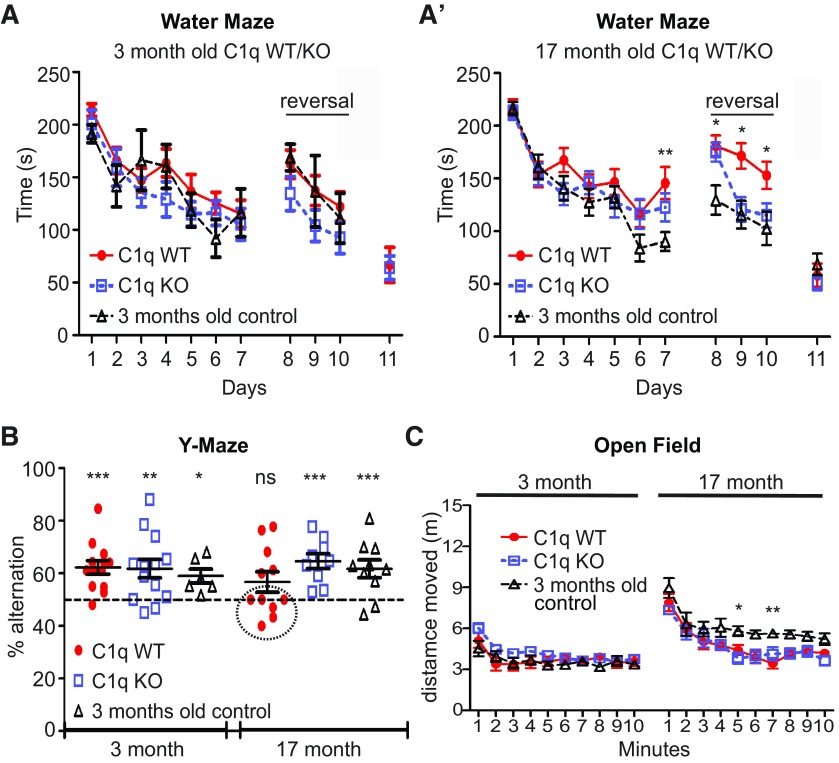Figure 9.
C1q-deficiency reduces cognitive decline during normal aging. A, MWM analysis, including reversal learning (days 8, 9, 10; total escape latency per day shown) revealed enhanced cognitive flexibility in aged C1q-deficient (KO) mice. A, 3-month-old (adult) KO, their WT littermates, and 3-month-old control mice performed all parts of the experiment without significant differences. A′, Learning of the hidden platform location (days 1–7) was nearly identical between 17-month-old (aged) KO mice, their WT littermates and 3-month-old control mice. Only on day 7, the 3-month-old control performed significantly better than the aged WT (p < 0.01). However, no significant difference in learning was detected between 3-month-old controls and aged KO mice (p > 0.05). On the first day of the reversal learning task (day 8), 3-month-old controls found the new location of the hidden platform faster than both aged KO and WT mice (WT vs 3-month-old control: p < 0.05; KO vs 3-month-old control: p < 0.05). However, aged KO mice performed at the two subsequent reversal learning days as fast as the 3-month-old controls (day 9: p > 0.05; day 10: p > 0.05). This was in strong contrast to the aged WT mice which showed reduced reversal learning at both days, consistent with an age-related decline in cognitive flexibility (day 9: WT vs KO: p < 0.05; WT vs 3-month-old control: p < 0.05; day 10: WT vs KO: p > 0.05; WT vs Bio Ctrl: p < 0.05). There were no significant differences between the cohorts at all ages during visible platform learning (day 11), indicating that all animals were able to see. B, Y-maze analysis revealed intact spatial working memory in aged KO mice. KO mice performed spontaneous alternations in the Y-maze task at all ages significantly above chance (50%) and equally well as the 3-month-old controls (KO: 3 months of age, p = 0.0059; corresponding 3-month-old control, p = 0.0188; KO: 17 months of age, p = 0.0009; corresponding 3-month-old control, p = 0.0072). In contrast, although young adult WT mice were able to learn the task (p = 0.0004), a large proportion of aged WT mice did not perform above chance levels (circled subjects), particularly indicating the subjects with age-related decrease in spatial working memory (17-month-old WT, whole group mean: p = 0.1158). C, Open field analysis confirmed that KO mice have activity levels identical to the WT at both 3 (adult) and 17 months (aged) of age. As to be expected, the 3-month-old control mice traveled slightly longer distance than the aged KO and WT mice (significant difference between C1qWT/KO and the 3-month-old controls at 5 min: p < 0.05, and 7 min: p < 0.01; no significant difference at all other time points (p > 0.05)). Three-month-old: n = 13 WT, n = 13 KO littermates; 17-month-old: n = 11 WT, n = 9 KO littermates; 3-month-old control: n = 10; *p < 0.05, **p < 0.01, ***p <0.001. Values and error bars represent mean ± SEM.

